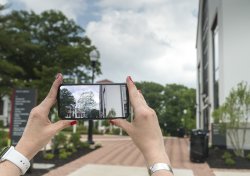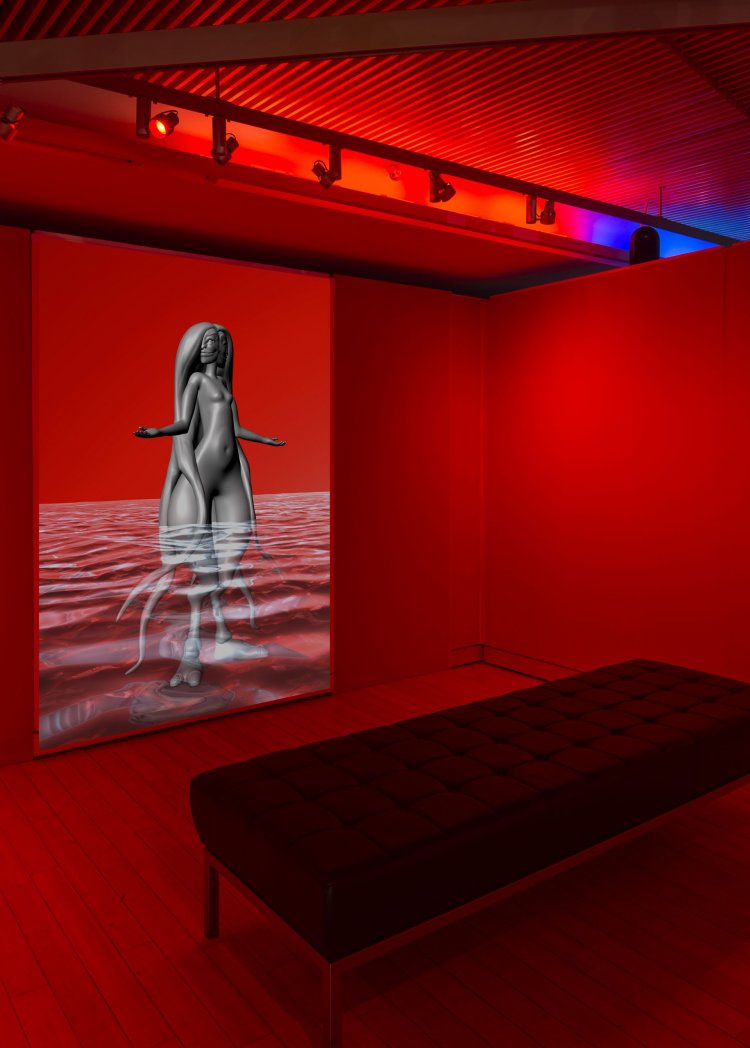University Galleries Reopen With ‘Tech/Know/Future/ From Slang to Structure’
Timely work by contemporary artists marks a return to in-person art exhibitions on campus
Posted in: University Galleries News

The Montclair State University Galleries are back with a new director and the first in-person exhibition in nearly two years.
Tech/Know/Future/ From Slang to Structure runs September 14 through December 11 with an opening reception on Thursday, September 23. Dynamic works of art will be installed around campus and in gallery settings, bringing art to the University community in surprising and inventive ways.
Under the direction of University Galleries Director Megan C. Austin, the exhibition is curated by Tom Leeser, director of the Art and Technology Program and the Center for Integrated Media at CalArts, who has brought together a group of innovative artists including: Morehshin Allahyari, Salome Asega, Nancy Baker Cahill, Stephanie Dinkins, Carla Gannis, Taehee Kim, LoVid, Amelia Marzec, Olivia Mole, Sondra Perry and Casey Reas.
These 11 diverse cross-disciplinary artists present a critical response to technological systems within art addressing the issues of identity, history and abstraction, placing the viewer at the intersection of the past, present and future. The artists use their creative practices to establish new relationships between technology, knowledge and time through augmented reality, artificial intelligence, sound, video, textiles and works on paper.
The show is part of Austin’s vision to revamp Montclair State University Galleries programming to focus on exhibiting new and timely work made by contemporary artists who comment on the current state of social, political and visual culture.
“Working with artists and curators whose work provokes conversation around relevant issues that impact University students, faculty, staff and the greater community presents a unique opportunity for an academic institution to explore the contemporary art world and how the ideas presented by artists connect across disciplines and differences,” says Austin.
Leeser adds, “To date, my artistic, academic and curatorial practices have been built on creating
momentary experiences of art and technology within a critical framework of change. I’m very conscious of the accelerated states of flux within our political and cultural spheres, but the events of this particular moment caused me to pause – to reflect and to reconsider how we perceive time within the urgent task of generating greater diversity and social equality.
Tech/Know/Future/ From Slang to Structure is an assembly of artists and writers who produce genre-bending work, Leeser says.“To me, they represent what [Italian cultural theorist] Bifo Berardi calls the ‘complex constellations that comprise our present.’”
The exhibition draws inspiration from the essay “Iconic Treatise Gothic Futurism” by the late writer, artist and musician Rammellzee, and Berardi’s book After the Future.
Rammellzee designed a “technological language” to challenge the art world’s conventional approaches to image-making and writing. Berardi defines the future as a “cultural construction” of a materialistic, superficial, 20th-century society. He declares the mythology of the future is over, with the rise of global capitalism and its powerful “imaginary effects” to blame. Berardi’s post-future is a dematerialized, infinite present, a virtual space and time.

Among the highlights of the exhibition:
- Salome Asega’s immersive video installation POSSESSION portrays the underwater realm of the Pan-African water deity, Mami Wata. The spirit’s historical origin is West Africa; however, she was transported to the Americas and the Caribbean via the slave trade and diaspora. POSSESSION inhabits a space within the gallery bathed in a deep blue light.
- Nancy Baker Cahill’s Margin of Error, a site-specific augmented reality drawing in 360° in front of the newly renovated Susan A. Cole Hall. This augmented reality artwork is viewable on your smartphone via the artist’s 4th Wall App. The work is presented alongside a mixed-media-on-paper study. Margin of Error 01 exists in a nonlinear and perpetual time, which places the spectator in a circular and cloud-like space. Cahill’s piece engages in a deeply physical environment while maintaining an ethereal, multidimensional quality.
- Morehshin Allahyari’s video installation, She Who Sees The Unknown: Aisha Qandisha, is part of a larger body of work and research that draws from the traditions of Arab and Islamic cultures. In a projection room inside of the Segal Gallery.the installation is engulfed in red light, while the video projects the mythological jinn Aisha Qandisha, a supernatural two-headed female with the legs of a hoofed animal as a reconstructed avatar. (See photo above)
- Carla Gannis’ Garden of Emoji Delights, a digital reworking of the famous painting, Garden of Earthly Delights by Hieronymus Bosch. Displayed via a monitor in the Segal Gallery, Gannis’ retitled work is a social media hallucination informed by our consumerist culture. By “digitally tagging” the Bosch painting and supplanting the original 16th-century characters with a plethora of emojis, the work multiplies the irreverence of the original.
- LoVid’s textiles, Place No Land and Pomegranates, are on view in the Segal Gallery and two more works, Tropical Time Frame and Borders, are on display in the Kasser Theater display cases on the first floor. These works were created using a series of individual video frames captured from the output of a custom-built analog video synthesizer. The frames were composed of the multi-colored glitches produced by a synthesizer and were manually translated into design layouts using software. They were subsequently fabricated as a series of wall tapestries. The work looks past mere historical references through a technological present that probes the transposition of electronics to fabric. Technology itself is the subject, not for adulation but to be considered within the context of the expanded electronic image.
- Sondra Perry’s ffffffffffffoooooooooooouuuuuuuuuuurrrrrrrrrrrrrrrrrrrrrrrrrrr, is the first exhibition for this edition of her video and bicycle workstation with four monitors. The video images are a self-portrait of the artist that, over time, liquefies into a deconstructed abstraction. The work projects the body within a contingency of time as it becomes transfigured, reprocessed and trans-mutated through a computer-generated alchemy. By placing an image of herself in the installation, Perry asks us to reconsider identity as an active construction in this indeterminate moment. This piece is also on view in the Segal Gallery.
- Olivia Mole’s Instagram augmented reality (AR) filter Take Back Future-Tripping is accessible via a QR code mounted in the Segal Gallery and across campus. Mole employs a strategy of AR-tagging with pink neon script that haunts space and is concealed until we visualize it through Instagram. The term “Future-Tripping” refers to a condition of exaggerated anxiety about the future. An example of the condition is the obsession with the question, “What if…?” Mole decides to take back the negative impulse of “What if… ?” by flipping it into a positive question. She asks us to consider – “What if no police, what if no borders, what if no capitalism, what if no domination is necessary to social existence after all?”
Gallery Hours
Tuesday – Saturday 11 a.m – 5 p.m.
Opening Reception
Thursday, September 23, 2021
5 – 7:30 p.m.
6 p.m. Remarks from Director Megan C. Austin, Dean Daniel Gurskis, and curator Tom Leeser
To register to attend, visit the event registration page.
Join the conversation on social media by tagging @montclairstategalleries and using the hashtags #TechKnowFuture and #MontclairStateGalleries when posting.
This exhibition is made possible, in part, by funds from the McMullen Family Foundation, the College of the Arts, and private contributions.
